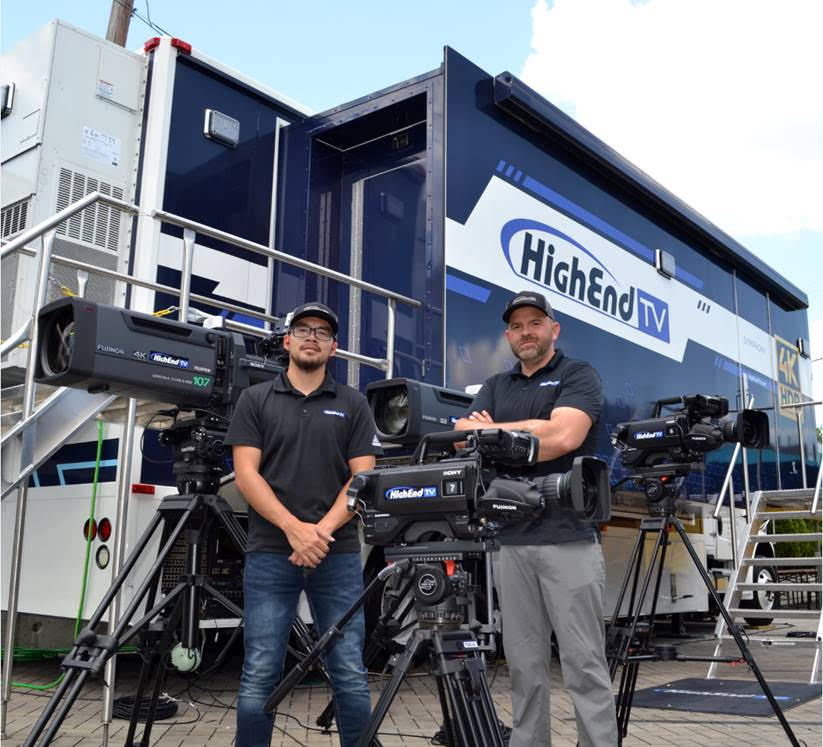High End TV Debuts 4K HDR Production Truck
Production coordinator Adam Mills talks about the value of going all the way with 4K HDR and some of the challenges in building a full 4K, HDR truck

NASHVILLE, Tenn.—High End TV has launched a new full 4K HDR production truck called Symphony. Built to provide uncompromising cinema-grade picture quality, the company is billing it as the only truck in the U.S. outfitted entirely with Sony 4K HDC-5500 cameras and Fujinon 4K lenses, plus Grass Valley Kayenne XP 4K loaded, all with 100% 12G, 4K throughput and monitoring.
While production trucks with complete 4k/HDR production capability from camera to recording and monitoring are still unusual, High End TV has a history of being an early adopter of high quality formats.
“High End TV started in 2006 to do those rare `high end' projects that required high definition,” explained production coordinator Adam Mills. “Of course as HD became the norm, our company grew to support that demand. Most of our work is concerts, including touring video for IMAG and broadcast/theatrical release. With COVID-19, that evolved into virtual concerts for drive-in movie theaters and web release.”
When asked about their decision to go all 4K HDR, Mills explained that “every piece of gear on this truck is 4K and HDR compatible—every lens, camera, monitor, and recorder. Why? It reminds me of back in the day when a truck's entire monitor wall was black and white…for a color broadcast. Likewise, now, so many `4K-capable' trucks have no 4K monitors, no 4K glass, and HDR monitoring is completely impossible. Was that shot in focus? Is that overexposed picture OK to take - still in range for the HLG acquisition? You could keep your fingers crossed, but the directors I know like to see what they're doing, and the camera operators like to have the best tools for the job. We just wanted to build it right.”
The demand for 4K productions, along with all types of productions took a big hit during the pandemic but is now improving.
“All the projects we had planned for this truck, originally set for its debut in March 2020, were cancelled due to COVID-19,” Mills said. “I am seeing more and more reasons to justify HDR and 4K distribution now though, so hopefully those projects will come back soon. For example, the resolution map of LED walls, especially with a 3mm product, can exceed 4K and beyond quite easily, even at a moderate size concert or festival. If an event is `just for streaming,’ well...most platforms can handle 4K; many even require it. Furthermore, even if a production is intended for HD broadcast, a 4K truck in HDR provides you a ton of latitude in post, makes for a future proof program, and will simultaneously produce the best HD picture. I have to say, once you see real 4K in HDR, it's tough to go back to REC.709/1080i.”
One of the key technologies in delivering that look, Mill said is the Sony 4K HDC-5500 cameras.
The professional video industry's #1 source for news, trends and product and tech information. Sign up below.
“The global shutter 4:4:4 sensor of the Sony HDC-5500 is a game changer, especially with high-motion, LED-heavy (and sometimes 24p) production that great concerts demand,” he explained. “With HLG, live HDR range and simultaneous SDR output, literally every resolution/frame rate/color space is possible with these cameras. And with a 35mm version of the same camera on the horizon (otherwise same CCUs and accessories), I think Sony has hit a homerun. When you bundle them with Fujinon UA glass - magic happens. Extra-low dispersion glass with fluorite elements of the lens, plus ALAC and flare compensation of the cameras make for the purest, most consistent color I've ever seen in a lens family. Add to that breathing and ramping compensation, crazy sharpness, and the huge exposure overhead of HDR, it's a shader's dream.”
Going to a full 4K HDR truck wasn’t easy however.
Putting it together “was more difficult than you would think,” Mills said. “For example, in the planning stage, a real 4K switcher (one that did not half or quarter the resources in 4K mode) didn't exist - though every major manufacturer was promising one soon, only not yet. So our plans centered around a switcher that didn't exist. In the meantime, the native 12G models have come out, and we ended up integrating a Grass Valley Kayenne K-frame XP to fit the bill.”
“For 100% 4K and HDR, I think we were and are a little ahead of the curve,” he continued. “With new standards and new protocols, we've had our share of `isms’ in the testing phase, and we've helped a few companies find some `known issues’ along the way. We've had some vendors re-write firmware to make their products function as advertised, their tech support saying things like `wait, you're actually using that in 4K, HLG already?’ I don't want to call anyone out, but I am comfortable saying at this point, we've rounded the corner where everything is doable in 4K/HDR as you would expect - no band aids and duct tape, just a slightly higher price tag.”
George Winslow is the senior content producer for TV Tech. He has written about the television, media and technology industries for nearly 30 years for such publications as Broadcasting & Cable, Multichannel News and TV Tech. Over the years, he has edited a number of magazines, including Multichannel News International and World Screen, and moderated panels at such major industry events as NAB and MIP TV. He has published two books and dozens of encyclopedia articles on such subjects as the media, New York City history and economics.

